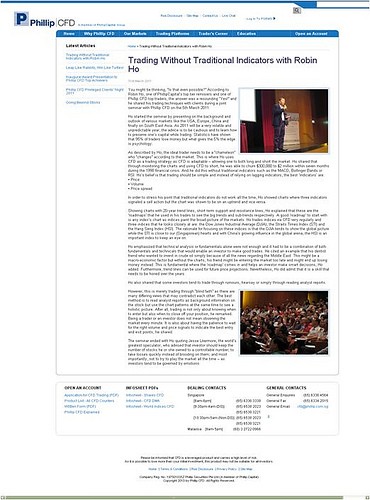Mastering Short Term Trading with Robin Ho
Post on: 30 Июнь, 2015 No Comment

Mastering Short Term Trading with Robin Ho
Robin Ho
Ever wanted to know what it takes to be a successful trader? How to profit from Chart Patterns and what techniques to apply to short term trading? PhillipCapital’s top tier remisier and one of Phillip CFD’s top traders, Robin Ho, answered these questions and more during his seminar on 22nd October 2011. Drawing on his many years of experience as a trader, Ho shared with the audience how the current market situation is meant more for mid to short term trading rather than long term investments. To add, the increased volatility may be due to the proliferation of auto or algorithmic trading.
Reiterating his view stated during his previous seminar in March, Ho said that traditional indicators such as the Moving Average Convergence Divergence (MACD) and Relative Strength Index (RSI) are not as useful as simple trend lines which are able to show traders how the particular stock or index is doing. In addition, successful traders often rely on price action (i.e. volume and price) to determine trends, which are especially important in trading because everything moves in cycles. Thus, another attribute that traders must have is flexibility – being able to change one’s trading strategy in tandem with the market. This is where Ho uses Contracts for Difference (CFD) as it allows him to long and short the market with relatively low execution costs.
Many members of the audience asked for advice on intra-day and short term trading, to which Ho replied that intra-day trading is definitely not something for novice traders. He even admitted that despite his experience, he finds it tricky to intra day trade. Nevertheless, according to Ho, a successful trader (be it in the short or long term) needs the following characteristics:
- Good understanding of the market(s) one is trading in
- Have a sound and proven trading strategy or strategies
- Charting tools

Having a good understanding of the market means recognising trends as well as ‘danger zones’ when they occur. It is important to ask yourself the following questions when observing any charts, “Where am I in the big picture? Am I riding up, down or sideways in this trend?” If one is trading on the short term, they should look at charts with shorter time frames while those trading on the long term should look at charts with longer time frames. For example, Ho uses a 1-minute chart and a 30-minute chart whenever he does intra-day trades. Moreover, using multiple charts with multiple time frames increases the accuracy of one’s interpretation of the trend. Nevertheless, there is no magic formula to earn profits all the time whilst trading and it is key to have proper money management.
Based on Ho’s observation, the Asian markets will be greatly affected by the goings on in Europe. As such, even if one does not trade in the European market, it is imperative to look at the DAX (Deutscher Aktien IndeX) as it closely affects the movement of the Hang Seng Index in Hong Kong and is a leading indicator. To add, one has to be cautious because a recession in Europe is expected and as such, the market has already priced that into the European stocks. Thus, when European stocks hit a low, it is best to be patient and watch these stocks as European banks may rise again from that point.
From the economic data, the European crisis is in fact more serious than the US as the US is dealing with a bank crisis while Europe is experiencing sovereign debt crises. The irony is that the best performing index so far is the Dow Jones. Ho also mentioned that the Euro crisis was an issue that the world was aware about a year ago but nothing much was done to prevent it from disintegrating to the situation it is today. Due to the similarities, Ho warned the audience to be wary about the shadow-lending business in China as he foresees this becoming an issue with China companies in the near future.
We would like to thank everyone who attended the seminar and to look forward to Robin’s next quarterly seminar, to be held in March 2012. More details will be released soon.
You may be interested in.














